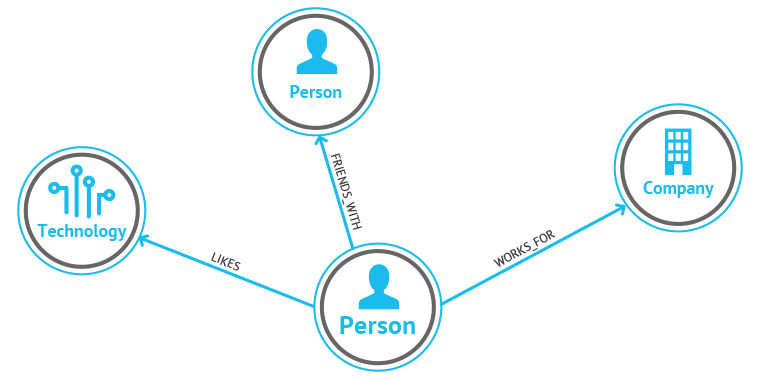Contents
Graph databases, renowned for their ability to efficiently manage and analyze complex interconnected data structures, offer a flexible and scalable solution for navigating intricate relationships and dependencies across diverse domains. One of the most widely adopted graph database management systems is Neo4J.
Graph databases Neo4j offer a comprehensive solution for efficiently managing and querying complex interconnected data. In this article, we will explore the fundamentals of graph databases and delve into the features, benefits, and usage of Neo4J.
What are graph databases?
A graph database is designed to represent and store relationships between entities. It consists of nodes, which represent entities, and relationships, which represent connections between nodes. Each node and relationship can have associated properties, providing additional information about the entities and connections. Understanding what graph databases are helps leverage their potential for managing connected data.
Various nodes (circles) are connected by relationships (arrows) that depict how different entities interact with each other. This graph database model effectively demonstrates how entities (persons, technology, companies) can be interconnected through various types of relationships, making it easier to visualize and analyze complex data structures.
The main types of graph databases include property graphs and RDF graphs, each suited for different use cases.
Key Features of Graph Databases
Graph databases offer several features that make them ideal for handling highly connected data:
- Schema-Free: Graph databases are schema-free, meaning they can handle data without predefined structures. This flexibility allows for easy adaptation to changing data models.
- Traversals: Graph databases excel at traversing relationships between nodes, making navigating and exploring complex networks easy.
- Graph Query Language: Graph databases provide a specialized query language like Cypher that simplifies querying and analyzing graph data.
Benefits of Using Graph Databases
There are several advantages of graph databases:
- Flexibility: Graph databases can handle evolving data models and are well-suited for scenarios where relationships play a crucial role.
- Performance: Graph databases can efficiently retrieve and traverse highly connected data, enabling fast query execution.
- Complexity Management: Graph databases simplify the representation and management of complex real-world relationships.
- Faster Development: The graph model’s natural representation of relationships allows developers to create applications faster and more easily.
Another critical advantage of graph databases is their ability to handle large-scale data sets. As data size increases, traditional relational databases may struggle to maintain performance and efficiency. However, graph databases excel in this area thanks to their optimized data structures and traversal algorithms.
Graph database vs. relational database
Several vital distinctions arise when comparing graph databases to relational databases, shaping their respective strengths and applications.
Relational databases, founded on structured tables and SQL, excel in managing structured data with predefined schemas, ensuring data integrity and consistency. They’re optimal for transactional systems and scenarios where data relationships are relatively straightforward.
On the other hand, graph databases specialize in handling complex interconnections between data points, leveraging graph theory, and traversing relationships efficiently. This makes them ideal for scenarios with highly interconnected data, such as social networks, recommendation engines, and fraud detection systems, where relationships play a major role.
What are graph databases used for? They are primarily used for scenarios involving complex relationships, such as social graphs and supply chain networks. While relational databases prioritize data integrity and consistency, graph databases prioritize flexibility and speed in navigating intricate relationships, offering distinct advantages depending on the nature of the data and the application’s requirements.
Application of Graph Databases
Graph databases find diverse real-world applications across various industries due to their ability to efficiently model and query complex relationships in data.
As graph NoSQL databases do not rely on predefined schemas, they are well-suited for evolving and complex data structures. In social networking platforms, they power recommendation systems by analyzing connections between users and their activities. Notable examples of graph databases are used by companies like Facebook and LinkedIn to power their social networks. Graph databases help detect suspicious patterns in cybersecurity and uncover hidden relationships indicative of potential threats.
They also play a crucial role in logistics and supply chain management, optimizing routes and tracking dependencies between different forms of nodes in the network.
Common graph databases examples include Neo4j, Amazon Neptune, and OrientDB. Overall, the versatility of graph databases makes them indispensable tools for tackling interconnected data challenges across numerous domains.
Top Advantages of Neo4j (Graph Database)
When exploring graph databases, Neo4j often stands out due to its robust performance and extensive community support.
Whether you are working on social network analysis, recommendation engines, or any other application that involves intricate connections between data points, Neo4J provides a robust solution. Among the most popular graph databases, Neo4j consistently ranks highly due to its powerful features and ease of use.
At the heart of Neo4J lies its ability to represent data as a graph, with nodes, relationships, and properties forming the building blocks of the database. This graph-based approach allows for efficient traversal of complex networks and enables the execution of sophisticated complex queries involving multiple connection layers.
Core Components of Neo4J
Neo4J consists of the following core components:
- Nodes: Nodes represent entities in the graph. Each node has a unique identifier and can have associated properties.
- Relationships: Relationships define the connections between nodes. They can have associated properties, just like nodes.
- Properties: Properties are key-value pairs that provide additional information about nodes and relationships.
These components work together seamlessly to create a rich and interconnected data model that can capture intricate relationships and dependencies in a way that traditional databases struggle to emulate.
Advantages of Neo4J in Graph Databases
Neo4J offers several advantages as a graph database management system:
- High Performance: Neo4J is optimized for handling highly connected data, allowing for fast querying and traversal operations.
- Scalability: Neo4J can scale horizontally, enabling the management of large and growing datasets.
- Community Support: Neo4J has a vibrant and supportive community that provides resources, tools, and extensions to enhance its functionality.
These advantages make Neo4J a popular choice for organizations and developers looking to leverage the power of graph databases in their applications. Neo4J’s performance, scalability, and community support contribute to its reputation as a leading player in the world of graph database management systems. Getting started with graph databases often involves learning a query language like Cypher and understanding basic graph theory.
Who uses graph databases
Graph databases are utilized by a diverse range of professionals and organizations across various industries. Data scientists and researchers leverage these databases to analyze complex relationships and patterns within large datasets, enabling advanced studies in fields like social network analysis, bioinformatics, and recommendation systems. Businesses, especially in sectors such as e-commerce, finance, and telecommunications, use graph databases to enhance customer relationship management, fraudulent activity detection, and supply chain logistics. Additionally, developers and IT professionals incorporate graph databases into applications that require efficient handling of interconnected data, such as content management systems, identity and access management, and real-time analytics platforms.
Graph databases use cases
Graph databases are particularly effective in scenarios that involve intricate relationships and connections between data points. One prominent use case is social media platforms, which enable the efficient modeling and querying of user interactions, friendships, and content sharing. In the financial sector, graph databases play a crucial role in fraud detection by mapping and analyzing transaction networks to identify suspicious patterns. Another significant application is in recommendation engines, where they help in understanding user preferences and behaviors to suggest personalized content, products, or services. Additionally, graph databases are employed in knowledge graphs to enhance search engine capabilities, allowing for more accurate and context-aware search results by understanding the relationships between different pieces of information.
Conclusion
Graph databases are revolutionary for managing and analyzing complex, interconnected data. Neo4J, as one of the leading graph database management systems, provides powerful tools and features to harness the full potential of graph data. By understanding the fundamentals of graph databases and exploring Neo4J’s capabilities, users can efficiently model and query relationships within their data, leading to more insightful complex analysis and decision-making.
Whether you’re dealing with social networks, recommendation systems, or any other domain with intricate data connections, Neo4J stands out as a robust solution for navigating and leveraging the complexities of your data landscape. To sum up, Neo4j graph databases are renowned for efficiently handling complex, interconnected data structures.
Get your projects built by our engineers, who are experienced in designing large-scale products using multiple technologies and databases with the highest security standards.









